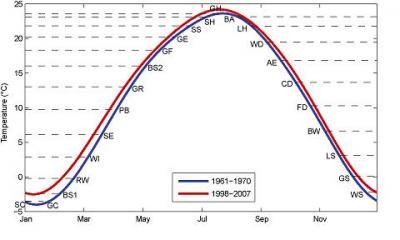A new study published in ESA Journals reveals how rising temperatures are reshaping the delicate balance of ecological communities by altering seasonal priority effects. As warming trends shift the timing and sequence of species’ arrivals each year, these changes are driving significant transformations in community composition. This research sheds light on the complex interplay between climate change and biological interactions, offering critical insights into how ecosystems may reorganize in a warming world.
Warming Alters Seasonal Priority Effects Impacting Ecosystem Dynamics
Recent studies reveal that rising temperatures are reshaping the timing of species arrivals and interactions throughout the seasons, significantly altering community assembly in various ecosystems. As warming accelerates, early arrivers gain an amplified advantage by establishing dominance before competitors emerge, fundamentally shifting the traditional balance of ecological succession. This seasonal reordering disrupts established priority effects, where species that colonize first shape resource availability and influence biodiversity patterns. Researchers have observed that these altered interactions can cascade throughout the food web, affecting nutrient cycling, predator-prey dynamics, and overall ecosystem stability.
Key implications of these warming-induced shifts include:
- Changes in species composition: Some native species may decline as early-season invaders monopolize resources.
- Altered phenological overlap: Synchrony between plants and pollinators might be disrupted, affecting reproduction success.
- Modified ecosystem functions: Shifts in dominance can impact processes like decomposition rates and primary productivity.
| Season | Traditional Priority | Warming-Shifted Priority | Ecological Impact |
|---|---|---|---|
| Spring | Native early-flowering plants | Invasive fast-growing species | Reduced native pollination |
| Summer | Established herbivores | Emergence of novel competitors | Altered trophic interactions |
| Fall | Seed dispersal timing | Advanced seed release | Changed recruitment rates |
Unraveling the Link Between Temperature Shifts and Community Composition Changes
Recent studies highlight how temperature fluctuations, particularly warming trends, disrupt the delicate balance of species interactions by altering seasonal priority effects. These effects determine which species establish dominance during community assembly, subsequently influencing overall biodiversity. As temperatures rise, earlier-arriving species gain an advantage through accelerated growth or reproduction, effectively outcompeting later arrivals. This shift not only redefines competitive hierarchies but also reshapes nutrient cycles and habitat structures. Critical to understanding these transformations is recognizing that temperature-driven priority effects can lead to cascading ecological consequences, affecting ecosystem resilience and function.
Key factors influenced by temperature shifts include:
- Species arrival timing: Earlier emergence or migration patterns favor certain species.
- Growth rates: Warming accelerates development for some organisms, tilting competitive advantage.
- Resource availability: Changes in phenology affect food and habitat resource windows.
The table below summarizes how different temperature scenarios influence priority effects and community outcomes:
| Temperature Scenario | Priority Effect Shift | Community Impact | ||||||||||||||||||||||||
|---|---|---|---|---|---|---|---|---|---|---|---|---|---|---|---|---|---|---|---|---|---|---|---|---|---|---|
| Moderate Warming (+1-2°C) | Earlier species gain advantage | Increased dominance of fast growers | ||||||||||||||||||||||||
| Severe Warming (+3°C and above) | Priority effect intensifies, latecomers excluded | Loss of species diversity, altered food webs |
| Temperature Scenario | Priority Effect Shift | Community Impact | |||||||||||||||
|---|---|---|---|---|---|---|---|---|---|---|---|---|---|---|---|---|---|
| Moderate Warming (+1-2°C) | Earlier species gain advantage | Increased dominance of fast growers | |||||||||||||||
| Severe Warming (+3°C and above) | Strategies to Mitigate Climate Driven Disruptions in Ecological Communities
To counteract the ecological upheavals triggered by warming-induced shifts in seasonal priority effects, it is crucial to adopt adaptive management strategies that prioritize resilience and flexibility within communities. Restoration projects, for example, should emphasize the use of native species with broad phenological plasticity-those able to adjust their life cycles in response to climate variability. This approach helps maintain ecosystem functions despite altered timing of species interactions. Additionally, monitoring programs employing real-time data analyses can detect early signs of disruptive shifts, enabling more timely interventions and minimizing long-term compositional changes.
Strategic deployment of conservation resources can be further refined through predictive modeling that integrates warming trends with community phenology. The table below outlines a simplified framework for prioritizing mitigation actions based on observed seasonal shifts and community responses:
In ConclusionAs climate change continues to reshape ecosystems worldwide, understanding the intricate ways warming alters species interactions is crucial. This study from ESA Journals sheds new light on how rising temperatures disrupt seasonal priority effects-those early advantages certain species gain-that in turn drive shifts in community composition. Such insights not only deepen our grasp of ecological dynamics under climate stress but also highlight the urgency of monitoring and managing biodiversity in a warming world. As researchers unravel these complex patterns, the path toward effective conservation strategies becomes clearer, underscoring the profound and often subtle impacts of global warming on natural communities. |































